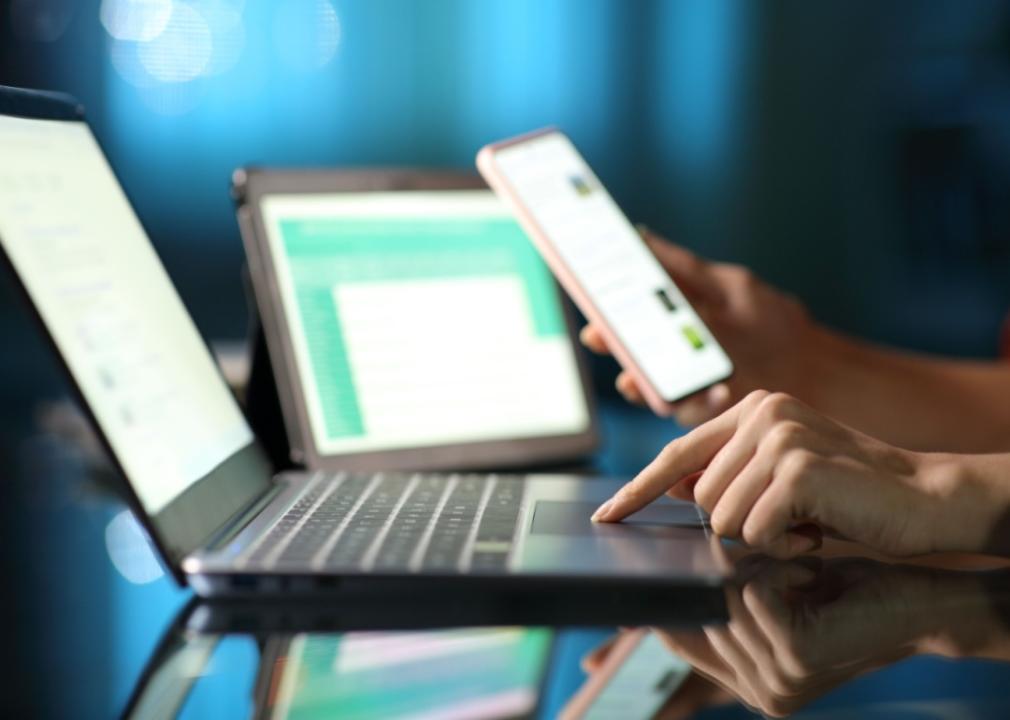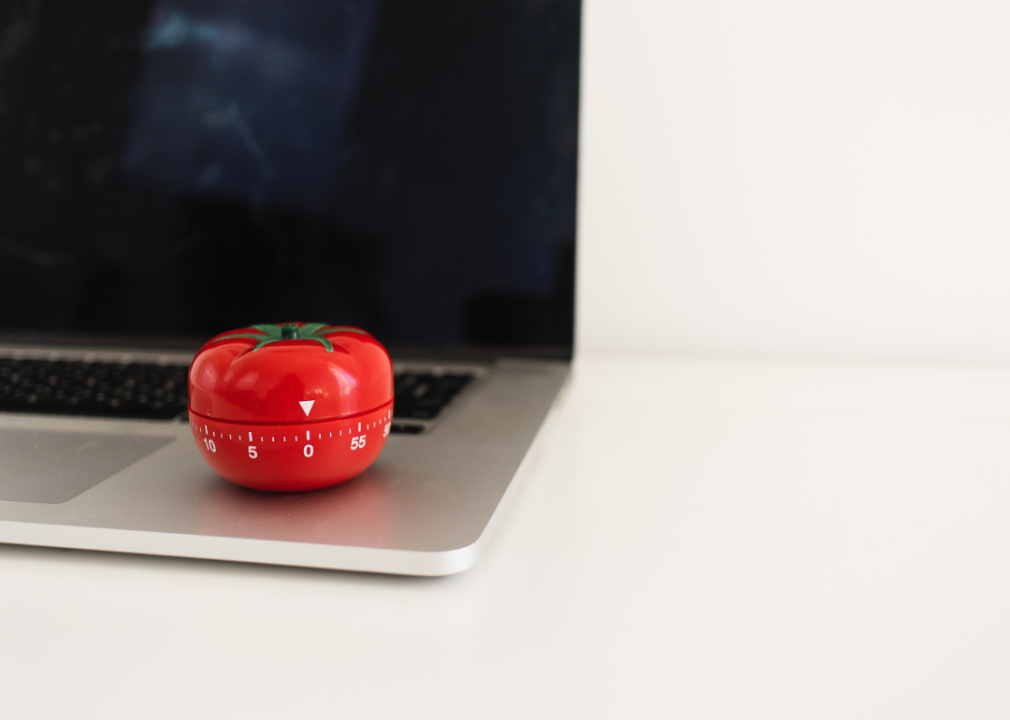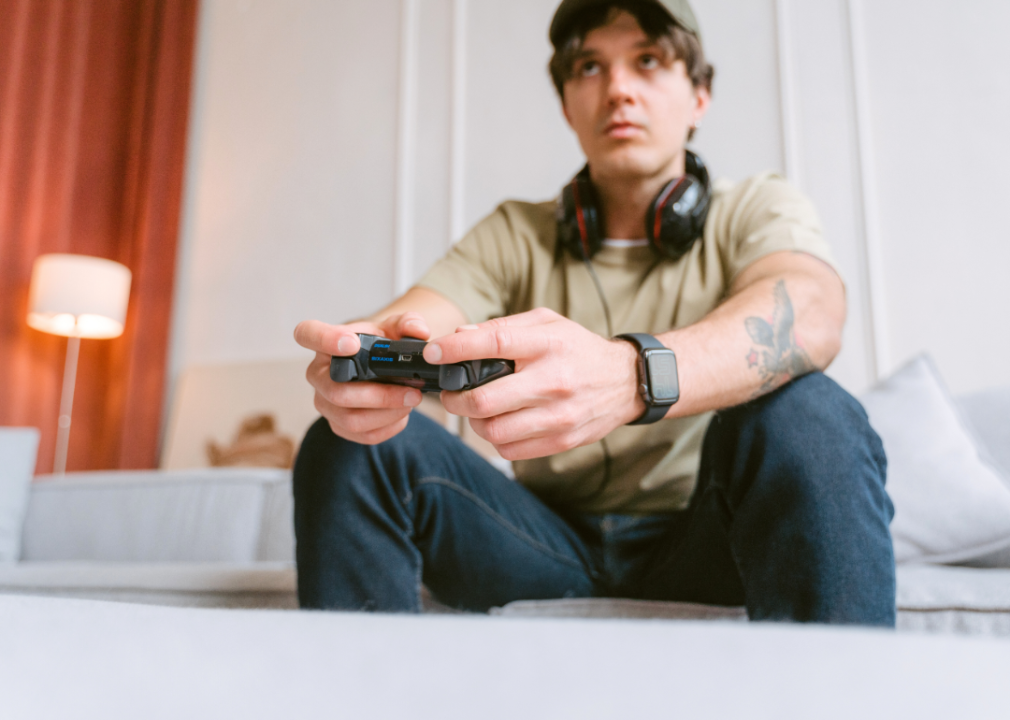'Media multitasking' might be fueling long-term forgetfulness and attention lapses

Antonio Guillem // Shutterstock
‘Media multitasking’ might be fueling long-term forgetfulness and attention lapses
A person on multiple media devices.
Chances are you’re guilty of “media multitasking”—and you might not even realize it.
Media multitasking can take several forms, like using your phone during a real-life social interaction. Reviewing Instagram comments while talking to a friend is one prime example. It can also mean performing tasks simultaneously on multiple forms of media, such as watching television while also posting on Facebook, or doing multiple tasks on one medium, such as listening to music while watching a video and writing emails on your laptop.
Officially, media multitasking means “monitoring and interacting with multiple streams of information simultaneously while also engaging in other tasks,” according to a 2022 Scientific Reports study. Though common, there are lots of costs to this behavior, including a lack of concentration, memory lapses, and forgetfulness.
ADHD Advisor investigated the impacts of media multitasking on attention and memory recall using scientific, peer-reviewed research studies.
In the Scientific Reports study, subjects were invited to use an electronic screen to estimate a line’s length and count dots. The tasks were presented individually or simultaneously and allowed participants to choose which to do or to switch between the tasks. Those who were presented with more than one task at a time had a “significant” decrease in their accuracy, and response time also suffered for participants in the scenarios involving counting.
In a different study, researchers at Stanford University found that media multitasking negatively impacts both working and long-term memory and is associated with memory lapses and forgetfulness.
Those who think they’re effectively multitasking are actually doing more things poorly. Engaging in multiple simultaneous activities can make it seem like more tasks are achieved. However, research shows overall net productivity is lower than if you did each activity individually, known as “monotasking.”
If you’re struggling to stay focused in a media-saturated environment, these tips will help you stay on task.
![]()

Canva
The Pomodoro method
A Pomodoro timer on a computer.
The name of this technique comes from its Italian creator who used a kitchen timer shaped like a tomato (“pomodoro” in Italian) to help focus while studying. Alternate 25-minute work sessions (pomodoros) with five-minute breaks. After four pomodoros, take a 20-minute break to recharge.
At the beginning of your work day, you decide how much time you can allocate to pomodoros, then divide your batched tasks and projects into an estimated number of pomodoros needed for completion. Distractions and interruptions will crop up, but the method requires they be delayed, deferred, or written down to address later.
If you have to stop a pomodoro, you take a short break and restart it. If you finish a task early, review and refine your work until the time is up. Studies show that working using a pomodoro-style system increases focus and decreases fatigue.

Canva
The GTD method
A woman and a child organizing a closet.
Often the hardest part of completing a task is getting started. Procrastination gets worse when our sticky notes are full of vague and sprawling projects like “taxes,” “back to school,” and “clean up for guests.” Enter “Getting Things Done,” or GTD, a method drawn from productivity expert David Allen’s course and book. It’s like a to-do list with superpowers.
GTD breaks every project in your life into the individual “next action” it takes to do it. Need to clean the garage, but oh wait, the garage is locked? Write down “look for key in junk drawer.” Once you have that little task figured out, it’s much easier to feel productive and keep the momentum to bang out the rest of the task.
The GTD approach can take a few hours to set up and requires daily and weekly maintenance to keep running smoothly. But once it gets going and you achieve “mind like water”—a state of clarity and focus where creativity and responsiveness come naturally—you’ll flow with ease and focus from one task to the next.

Canva
Block distractions
A man working on a computer while wearing headphones.
The other way to increase focus is to block distractions that steal our attention. Depending on the most common interruptions you experience, there are various ways to achieve this.
Some people are especially distracted by auditory and visual stimuli. They might choose to work in a room with a door they can shut, wear noise-canceling headphones or earplugs, or get up early in the morning before anyone else is awake. They reduce visual triggers by wearing a large-brimmed baseball cap, working with their desk facing the wall, or setting up a portable cardboard divider around their work area.
Other people find themselves especially distracted by social media. They can benefit from disabling notifications, using apps or devices that temporarily block social media and other noncritical apps, or deleting their social media apps and accounts entirely. There are also special single-purpose word processing apps and distraction-free devices that only allow for text entry, removing all attention-grabbing apps and toolbars. One can also just use paper and a pen, as long as you don’t need to sync to the cloud.

Canva
Make it a game
A man playing a video game.
There are those who breeze through their to-do lists, motivated by the pure joy of productivity and the satisfaction of a job done to its completion, driven by “intrinsic motivation.” Others need a little more help. For instance, research shows that people with ADHD possess lower levels of intrinsic motivation and respond better to “extrinsic” or external motivation, such as praise, prizes, money, etc.
Video games have practically perfected the art of motivating users to keep them. Instead of being distracted from your work by video games, you can use video games to get more work done by turning your work into a game.
Some productivity game apps are designed to be role-playing games, like Habitica, which features levels, swords, wizards, and gold coins. Others tokenize your productivity into units that nurture a virtual ecosystem (Forest), clean up a bunny’s house (Habit Rabbit), or have you ascend a ranking system and prod you to keep going with guilt-inducing humor (Productivity Challenge Timer) and the threat of losing hard-won rank.
Some people don’t respond to “gamification” while others love it. The bottom line is that productivity is about whatever works best for you.
Story editing by Alizah Salario. Additional editing by Kelly Glass. Copy editing by Tim Bruns. Photo selection by Lacy Kerrick.
This story originally appeared on ADHD Advisor and was produced and distributed in partnership with Stacker Studio.